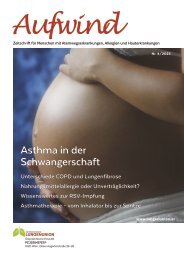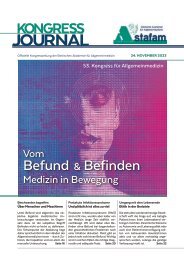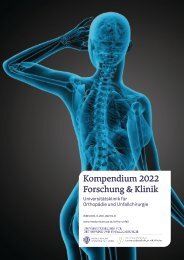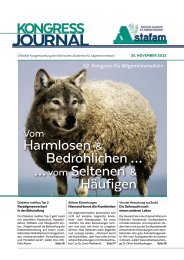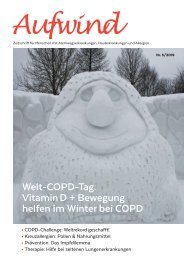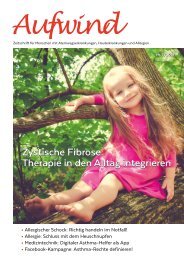Kompendium 2020 Forschung & Klinik
Das Kompendium 2020 der Universitätsklinik für Orthopädie und Unfallchirurgie von MedUni Wien und AKH Wien (o. Univ.-Prof. R. Windhager) stellt einen umfassenden Überblick über die medizinsichen Leistungen und auch die umfangreichen Forschungsfelder dar. Die Veröffentlichungen zeigen die klinische Relevanz und innovative Ansätze der einzelnen Forschungsrichtungen. Herausgeber: Universitätsklinik für Orthopädie und Unfallchirurgie MedUni Wien und AKH Wien Prof. Dr. R. Windhager ISBN 978-3-200-07715-7
Das Kompendium 2020 der Universitätsklinik für Orthopädie und Unfallchirurgie von MedUni Wien und AKH Wien (o. Univ.-Prof. R. Windhager) stellt einen umfassenden Überblick über die medizinsichen Leistungen und auch die umfangreichen Forschungsfelder dar. Die Veröffentlichungen zeigen die klinische Relevanz und innovative Ansätze der einzelnen Forschungsrichtungen.
Herausgeber: Universitätsklinik für Orthopädie und Unfallchirurgie
MedUni Wien und AKH Wien
Prof. Dr. R. Windhager
ISBN 978-3-200-07715-7
You also want an ePaper? Increase the reach of your titles
YUMPU automatically turns print PDFs into web optimized ePapers that Google loves.
TOP-Studien<br />
32<br />
Figure 1: Time integrated SDAI was significantly<br />
higher in patients with RCL (median; 25th and 75th<br />
percentile: 10.8; 8.6 and 15.8) than in controls<br />
without RCL (7.0; 2.7 and 15.5) (Figure 1; p=0.043).<br />
DMARDs had a protective effect on such risk. This link between inflammation<br />
and RCL was further substantiated in the comparison between RA and OA,<br />
being particularly evident for TKA.<br />
Priv.-Doz. DDr. Christoph Böhler<br />
Author:<br />
Christoph Böhler is a specialist<br />
for Orthopaedics and Traumatology<br />
at the Medical University of<br />
Vienna. His clinical and scientific<br />
focus are on primary and<br />
revision arthroplasty. In August<br />
2021 he will start a clinical<br />
Adult Reconstruction Fellowship<br />
at the University of Toronto,<br />
Canada.<br />
Local inflammation plays a pivotal role in the pathogenesis of aseptic loosening,<br />
by which generation of wear debris between the bearing surfaces<br />
leads to activation of macrophages and immune cells, which then release<br />
pro-inflammatory cytokines like TNF-alpha and IL-6. These induce osteoclast<br />
activation and lead to increased bone resorption, osteolysis and eventually to<br />
aseptic loosening. The systemic inflammation of RA may play a role in enhancing<br />
the local inflammation underlying the described processes leading to<br />
aseptic loosening. The implication of these findings for clinical practice are<br />
potentially substantial, at least for individuals with RA and TJA: no patients<br />
in remission showed RCL. Analogously to the observation that in sustained<br />
remission of RA joint damage does not progress, this makes the case that<br />
in the presence of TJA even stricter disease control should be pursued, with<br />
clinical remission being the clear treatment target. Biological DMARDs had<br />
a protective effect on the risk of RCL. Previously, it has been shown that<br />
TNF-inhibitors are able to stop the progression of joint destruction. The<br />
majority of the patients in the biological DMARDs group were treated with<br />
TNF-inhibitors, potentially also suggesting a role of TNF alpha in the mediation<br />
of the inflammatory process leading to aseptic loosening.<br />
Conclusion<br />
Taken together, inflammation in RA patients, as evidenced by higher levels<br />
of disease activity, increases the risk for radiographic loosening after TJA. In<br />
OA patients, as a control disease without systemic inflammation, the risk is<br />
significantly lower. Biological DMARDs may reduce the risk of RCL, although<br />
this would need prospective evaluation. Our data suggest that RA patients<br />
with TJA should regularly undergo orthopaedic and radiographic evaluation<br />
and, in the context of treating RA to target, might be considered for a more<br />
stringent control of disease activity.




